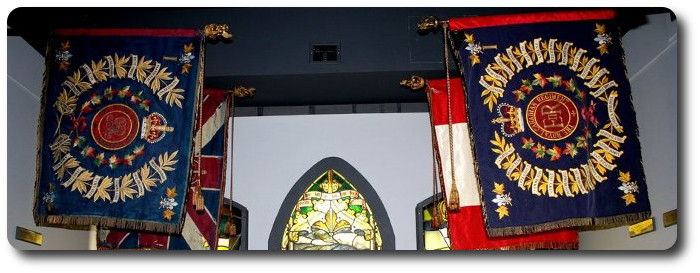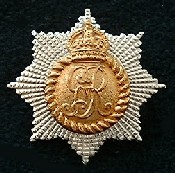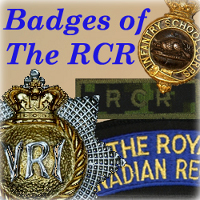
Researching The Royal Canadian Regiment
Nova Scotia's Part in the Great War
Compiled and Edited by M.S. Hunt (Captain R.O.); The Nova Scotia Veteran Publishing Co., Limited, 1920
CHAPTER IX.
THE ROYAL CANADIAN REGIMENT

During the early years of the reign of His Majesty King George V, the official badge (in the eyes of the Militia Department) for The RCR was that ensigned with the King's cypher. The Regiment, however, continue to wear "VRI" badges and to pursue official permission to wear the cypher of Queen Victoria, which was granted in 1919.
The Royal Canadian Regiment was raised on December 21, 1883, as a Unit of the new Canadian Permanent Force, for the instruction of the Canadian Militia by establishing schools of instruction for officers and non-commissioned officers, and by the formation of a nucleus of officers and non-commissioned officer instructors to assist at the various Militia Camps. The Regiment was first known as the "Infantry School Corps."
In 1885 "C" Company, stationed at Toronto, joined a mixed force of Militia under the command of Lieut.-Col. W. D. Otter, which marched across the ice along the North Shore of Lake Superior to the North-West, to suppress the rebellion &$8230; under the leadership of Louis Riel. The Company took part in the action of Fish Creek and the relief of Battleford on April 24th, and in the action of Cut Knife Hill on May 2nd. It also took part in the pursuit of Chief Big Bear during June and July. It remained in garrison at Battleford from July until October, when it returned to Toronto. This was the first occasion on which Canadian troops had conducted active operations and, brought them to a successful conclusion without the aid of Imperial troops.
In 1892 the name of the Regiment was changed to the "Canadian Regiment Infantry," and the following year Queen Victoria approved of the Regiment becoming a Royal Regiment, known as the "Royal Canadian Regiment of Canadian Infantry," and granted permission for her Imperial Cypher, V.R.I., with the Imperial Crown, to be worn as a badge.
In 1899, on the outbreak of the South African War, a second (Special Service) Battalion was raised under the command of Lieut.-Colonel W. D. Otter, and sailed on October 30, 1899, in the S.S. Sardinian, arriving at Cape Town on November 30th. In addition to minor skirmishes the Battalion took part in the following actions while in South Africa:
| Paardeberg | 27th February, 1900 |
| Poplar Grove | 7th March, 1900 |
| Dreifontein | 10th March, 1900 |
| Israel's Poort | 25th April, 1900 |
| Hont's Nek | 1st May, 1900 |
| Zano River | 16th May, 1900 |
| Doorn Kop | 29th May, 1900 |
| Pretoria | 4th June, 1900 |
The casualties in South Africa were thirty-nine killed, twenty-eight died of disease, one hundred and twenty-three wounded.
The Battalion was represented at the annexation ceremony at Pretoria on October 25th by a party specially selected, and on November 7th it embarked at Cape Town for Southampton, arriving on November 29th. The Battalion was inspected by Her Majesty Queen Victoria at Windsor Castle, when she addressed them and thanked them for their services. This was the last official inspection made by the Queen before her death.
On December 11th the Battalion embarked at Liverpool and sailed, for Canada, arriving at Halifax on December 23rd, where it was disbanded.
During the South African War the name of the Regiment was changed to the "Royal Canadian Regiment of Infantry." His Majesty King George, then Duke of York, presented colors to the Regiment at Toronto on October 11, 1901, during his tour of the British Empire.
A 3rd (Garrison) Battalion of the Regiment was raised at Halifax to release the 1st Battalion Leinster Regiment (Royal Canadians) for service elsewhere. This Battalion was brought to a high state of efficiency and formed the greater part of the Garrison in the Fortress at Halifax. It was, however, disbanded shortly after being relieved by an Imperial Regiment, the 5th Battalion Royal Garrison Regiment, in September, 1902.
In 1902 the name of the Regiment was once again changed, becoming known by its present distinctive title of "The Royal Canadian Regiment."
In 1904, a special banner, given by His Majesty King Edward VII to commemorate the Regiment's services in South Africa, was presented at Ottawa on October 4th by His Excellency the Governor-General, Lord Minto.
Imperial troops having been withdrawn and the defence of Canada taken over by local troops, the Regiment moved to Halifax, the establishment being raised to ten companies.
On the outbreak of the European War in August, 1914, the Regiment was mobilized at Halifax, occupying the various forts. It was brought up to war strength by a draft of four hundred volunteers, men from the newly formed Camp at Valcartier, for the Expeditionary Force then being raised. Being trained regular troops, and the only ones available for service Overseas, the Regiment, under the command of Lieut.-Colonel A. O. Fages, was sent to Bermuda on September 9th to relieve the 2nd Battalion Lincolnshire Regiment, and were the first Canadian troops to go abroad. In August of the following year, the Regiment having been re1ieved by the 38th Battalion, C.E.F., proceeded, under the command of Lieut.-Colonel Carpenter, to France, via England, where it was re-armed and re-equipped. It landed at Boulogne, under the command of Lieut.-Col. A. H. Macdonell, D.S.O., on October 31st, and on moving up the line immediately became Corps Troops to the Canadian Corps under Lieut.-General Sir A. E. H. Alderson, K.C.B. It went into the trenches for the first time with the First Canadian Division, opposite Messines.
At the beginning of 1916 it was one of the Battalions composing the 7th Canadian Infantry Brigade under Brigadier-General A. C. Macdonell, C.M.G., D.S.O., of the newly formed 3rd Canadian Division, under Major-General Mercer, C.B. The Brigade consisted of the Royal Canadian Regiment, Princess Patricia's Canadian Light Infantry, 42nd Battalion (Royal Highlanders of Canada) and 49th Battalion (Edmonton Regiment), and, later, the 7th Canadian Machine Gun Company. The Regiment went into the line with the Brigade at Wulvergham, moving afterward to Kemmel and then to Ypres.
The Regiment's first general action was that of the German attack on June 2nd to June 5th on Sanctuary Wood and Hooge, in the Ypres Salient. Here the Regiment, under Lieut.-Col. C. H. Hill, distinguished itself by its steadiness under the heaviest concentration of hostile artillery and trench mortar fire which up to that date had ever been brought to bear on British troops. By its rifle and machine gun fire the attempted infantry assaults against its lines were frustrated, and it was virtually the action of the machine guns, assisted by the 7th Canadian Machine Gun Company, that prevented a great disaster to the whole Ypres Salient. These guns had been unable to get away after being relieved on account of dawn breaking. On June 5th the Germans blew up three very large mines at Hooge, annihilating the Garrison. The guns, which were some distance in the rear, immediately mounted, fully exposed, on the Menin Road, and by their coolly directed fire threw back the German Infantry, thus preventing them from swamping our line and outflanking it both north and south on the Menin Road. The action of June 2nd to 5th exemplified the value of long training. The older men who had been in the Regiment for years, and who were considered as almost past their day, came to the fore wonderfully by their steadiness and discipline. This was shown particularly when during the hostile infantry attacks and intense shelling they remained cool and steady and withheld their fire, only letting forth their perfect deluge of bullets when a good target appeared. This encouraged and gave added confidence to the younger men. It was certainly the old soldier's day.
Between June and August some extremely gallant trench raids and expeditions were carried out by the Regiment. One raid carried out was discovered by the enemy before starting, and came under intense fire from rifles, bombs and machine guns at close quarters. In spite of this the party rushed forward and inflicted heavy losses upon the enemy, but every man except one was wounded. Two officers and some men came out into the open and worked for two hours under fire collecting and bringing in the wounded.
In September the Regiment moved south with the Canadian Corps under Lieut.-General Sir Julian H. G. Byng, K.C.B., K.C.M.G., M.V.O., to the Somme, where until November they took part in very severe fighting at Courcellette, Regina Trench, and elsewhere.
The Battalion performed a very difficult feat on September 15th, when it came up from reserve and occupied a line just after dusk over absolutely strange ground, made unrecognizable by shell fire, and in so doing was obliged to change front twice. They occupied their position on time. Again, on September 16th, two Companies went forward to attack an enemy trench over open ground, in full view of the enemy, in face of deadly rifle and machine gun fire, starting at a distance of over 800 yards and being practically wiped out when less than 50 yards from the enemy's trench.
On October 8th, at Regina Trench, the R.C.R. and one other, Battalion were the only Canadian Battalions to capture and for the time hold objectives. There by its gallantry and determination the Battalion held on throughout the day outflanked and unsupported. A Battalion of German Marines was threatening the left, which necessitated a change of front. This was successfully accomplished: The enemy charged the position on three separate occasions, but were driven back with heavy loss each time. This, however, was accomplished only by heavy loss to the Battalion, for, when relieved, it mustered only one officer and eighty-one other ranks; in one Company only five men remained.
On leaving the Somme area the Regiment was so depleted that it was obliged to reorganize. The fighting had been of the bitterest hand-to-hand kind.
The following order was published on leaving the area:
7th Canadian Infantry Brigade.
This Brigade has just finished a series of operations of which every member may be justly proud.
The performance of the 15th September, 1916, when the R.C.R., P.P.C.L.I., 42nd and 49th Battalions; went into an unknown area. on four and a half hours' notice, in broad daylight and under heavy shelling reached and jumped off on time, not from prepared assembly trenches, but from a battered trench captured that morning, and, changing direction twice, captured and held three different objectives, together with some three hundred prisoners, has been characterized as one of the finest accomplishments by any Brigade in the war.
No one as time goes on can fail to be more and more impressed with the extent to which each arm of the military machine is depel1dent upon others for ultimate and lasting success; a Brigade may do better than ever before, and 'still fail to gain their objective, owing to another arm not having fully accomplished its task.
The attack on September 16th, 1916, adds to, rather than dims, the glory. Both the R.C.R. and the 42nd Battalion (R.H.C.) knew the barrage had failed, that the Zollern Trench was fully manned, and that the chances of success were slight. Notwithstanding, the attacking companies of these Battalions did their duty. knowing that the attack of the 9th Canadian Infantry Brigade, timed for 6.30 p.m., depended entirely on their capturing their objective. They thrust the attack home gallantly and well, but, under the circumstances, with the odds so heavily against them, it was impossible to make good the Zollern Trench.
On the 8th October, 1916, Regina Trench was not battered in nor the wire cut, but we all have good reason to be proud of the performance of our Rattalio1ls that day-the R.C.R. and 49th Battalion for their attack, the P.P.C.L.I. for their good work in the vacated front line, and the 42nd Battalion (R.H.C.) for cheerfully going in again to take over the defence of the line, although they had been withdrawn a few hours before and were desperately tired. The Machine Gun Company also comes in for its share of the well-earned praise for its excellent barrage work and support of the Infantry.
We all feel particularly proud of the splendid work of the R.C.R. in driving through to their objective and holding it so long against odds. No one could have done better and few so well.
A. C. MACDONELL, Brig.-Gen.
Comd'g. 7th Canadian Infantry Brigade.
15-10-16.
In November the Battalion moved north again to Neuville St. Vaast, nothing of much importance happening with the exception of raids. These commenced after Christmas and became almost a daily occurrence. Daring deeds of all degrees were performed by all ranks, with the result that the Battalion was morally and actually master of the situation and owned "No Man's Land."
On April 9, 1917, the Battle of Vimy Ridge commenced. This was one of the most perfectly planned actions that has ever occurred. Every man knew exactly what he had to do and how to do it, and where he was to go. The strong ridge which the Germans had held and fortified to the best of their ability fell into our hands with comparative ease. Many trophies were captured by the Regiment, and all their objectives were taken without any delay or hitch of any kind. This was accomplished in bitter weather and mud knee deep; the ground captured was held intact in spite of the furious and continued attacks launched by the enemy to wrest our gains from us.
After Vimy the Regiment took part in the following major actions: Avion, June, 1917; Hill 70, July, 1917; Passchendaele, October and November, 1917 (in the latter period eleven hostile attacks were successfully repelled); Amiens, 1918, where the Regiment was on the extreme right successfully operating with the French; Monchy, August, 1918; Cambrai, where Lieut. M. F. Gregg won his V.C.; Foret de Raisines, Valenciennes; and last, but not least, the dramatic capture of the world famous Mons. The credit for the first to enter Mons has been claimed by the 42nd Battalion. This is a moot point, and is probably due to the fact that a Company of the Royal Canadian Regiment was detached to the 42nd and entered the City from the S.E. The indubitable fact remains that Lieut. W.M. King of the R.C.R. was the first to reach the square, where he was received by the Mayor at the Town Hall with his platoon, and where he signed the Golden Book of Mons, which was given by King Albert to the City on his departure in 1914.
The Regiment returned to Canada and the C.E.F. personnel was demobilized at Halifax on 11th, March, 1919.
The following honours and and awards were gained by the Regiment in the war:-
| V.C. | 1 | |
| G.B. | 1 | |
| C.M.G. | 4 | |
| C.B.E. | 1 | |
| D.S.O. | 11 | |
| O.B.E. | 5 | |
| M.C. | 37 | |
| Bar to M.C. | 5 | |
| D.F.C. | 1 | |
| D.C.M. | 24 | |
| Bar to D.C.M. | 1 | |
| M.M. | 128 | |
| Bar to M.M. | 10 | |
| M.S.M. | 10 | |
| Foreign Decoration | 15 | |
| Mentions | 35 | |
| Commissions from the ranks: | ||
| Lieut.-Colonel | 1 | |
| Major | 5 | |
| Captain | 14 | |
| Lieutenant | 28 | |
| 2nd Lieutenant | 4 |


